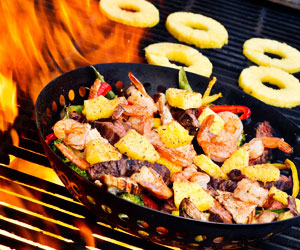I have an admission to make: Although I’m not an anthropologist, I have determined definitively, through informal surveys of a few good friends, that the love of aromas found in smoke is locked securely into our genes.
There’s just something about meat and fire. You can bake, broil, poach, pan-fry, deep-fry, toast, roast, braise, and sauté to your heart’s content. But sooner or later, the mercury will rise, the weekend will arrive, your friends will stop by, and—just like that—you’ll find yourself standing outside on the patio, sporting a “Kiss the Chef” apron, cooking meat with fire. Or, more precisely, slow-smoking meat on a grill, American-style.
While you’re doing it, you’re probably also having an argument with those same friends about who does it best, which state or region has the best baby-backs, and the best tools of the trade.
No other cooking technique inspires so much lively discussion and debate. Gas or charcoal? Carolina or Kansas City? Beef ribs or pork? What’s the best marinade for chicken, shrimp, and grilled swordfish? What’s the best rub for steak? And how long should you smoke a pork shoulder before the pig pickin’?
Good and valid questions, all, and discussions well worth having. But let me suggest that we take things to the next level. Instead of restricting our debates to domestic issues, let’s go global with our barbecue. After all, as Planet Barbecue author and PBS “Primal Grill” host Steven Raichlen likes to point out, this is a cooking technique that’s practiced on all seven continents of the globe.
But once you venture outside the U.S., grilling becomes more about fast, high-heat, open-flame cooking as opposed to slow smoking. There’s even more than one way to barbecue your favorite beef hind-quarter; Francis Mallman, guru of Argentine grilling, says there are seven (yes!) types of fire with which to hone your smoking technique. Not surprisingly, each recipe or cut of protein will determine the type of fire that’s used. The questions, therefore, should be extended to include: Korean or Cambodian? Dry chimichurri or Jamaican jerk spice rub? Teriyaki or Thai peanut sauce? Japanese robata grill or Indian tandoor?
In just about every case, there are commonalities: Protein is seasoned or marinated, placed on a barbecue contraption, cooked quickly, and dusted, drizzled, or drenched with some sort of condiment.
The real beauty of barbecue, and the aspect that often gets overlooked, is that it can play a role in just about every daypart and menu category at most types of concepts. Think about it: Pizza chains can sear ham and sausage for use on breakfast pizzas, as well as the standard lunch and dinner varieties. And, of course, you can even barbecue the whole pizza itself for an intoxicating infusion of smoke into the dough. Smoked pork works as well in a breakfast taco as in a more conventional lunch or dinner burrito. And as San Francisco’s Magic Flute Garden restaurant has ably demonstrated, smoked chicken hash can be a heck of a way to start your day.
But why stop there? In addition to being useful all day long, barbecued elements can work on just about every section of your menu. Rice and lettuce bowls with barbecued meats and grilled vegetables are becoming a mainstay at many concepts. Chilean barbecue bowls, Mongolian-style beef bowls, Mediterranean chicken bowls … the possibilities are as expansive as a world map.
Grilled or smoked peaches, popular in many corners, and other types of grilled fruits could liven up the dessert category. For a leap into the world of beverages, intrepid souls could consider the very hot trend of smoking drinks or the components that go into them. Sandwiches and salads are obviously adaptable enough to suit whatever global barbecue style you want to showcase. And side dishes featuring seasoned, grilled veggies are increasingly popular. At Wexler’s in San Francisco, the smoker is working overtime, handling everything from cauliflower to golden raisins and cipollini onions.
Indeed, the creative outfits that are experimenting successfully with global barbecue offer a strong sense of its potential to go more mainstream.
In Los Angeles, the Kogi BBQ taco truck—led by celebrity chef Roy Choi—set off a mobile and street-food revolution with its Korean barbecue menu options, which include Short Rib Tacos, Spicy Pork Burritos, and Kimchi Quesadillas. The first truck was so successful the brand grew to include three additional trucks and a brick-and-mortar restaurant, Chego.
The Flying Pig food truck is also roaming L.A. streets with an Asian-style, hickory-smoked chicken thigh with mango slaw, honey-roasted peanuts, and green curry aioli. Up the I-5, in Portland, Oregon, the proprietors of the Tabor food truck are doling out German smoked sausage with Czech dumplings, sauerkraut, and mustard. And in Prairie du Sac, Wisconsin, the Blue Spoon Café offers a pulled-pork quesadilla with chipotle sauce, Cheddar cheese, onions, and peppers.
In the end, whichever route you choose to go, you’re going to come out on top when you work with fire, good ingredients, and creative spice and seasoning combinations. The key is to think outside the smoker—and look to the four corners of the globe for grilling inspiration as you work to enliven your menu.













